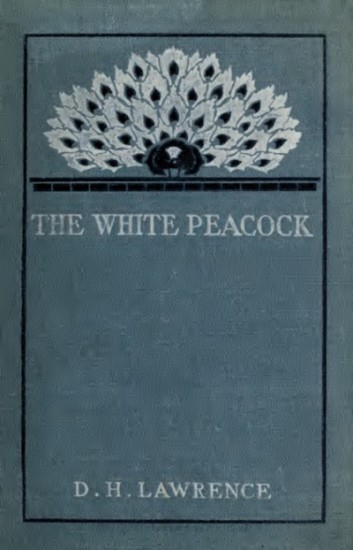
Ken Worpole on D.H.Lawrence’s, The White Peacock (1911)
It is now some thirty years since I visited Lawrence’s childhood home at 8a Victoria Street, Eastwood, Nottinghamshire, which by then had been modestly adapted as a museum, recreated as it would have been when the Lawrence family lived there. The memory stays strongly with me, of a small, neatly furnished terrace house, with lots of dark greens and browns in its interiors, somehow at one with the colour range of the fields and woods beyond. Lawrence’s father was a miner, but his mother had come from more propitious circumstances, and it was her love and ambition for the young Lawrence (1885 – 1930) that propelled him out of Eastwood – where for a long time he was regarded as a fantasist and writer of ‘dirty’ books – to a life of international travel and literary acclaim, concluded too early by ill-health and TB.
From Victoria Street it is still easy to walk out into the nearby countryside to Haggs Farm, where Lawrence fell under the spell of a young woman, Jessie Chambers, and her generous and hospitable family. In later life he wrote that, ‘Whatever I forget, I shall never forget the Haggs – I loved it so. I loved to come to you all, it really was a new life begun in me there.’ It is only by making this walk that one realises just how much a small piece of territory can suffice a lifetime’s memories and attachments. Many of the rural settings which provide the scenery for The White Peacock, and subsequently Sons and Lovers, Women in Love, and Lady Chatterley’s Lover, are all based on this small patch of terrain connecting Eastwood – with its ten collieries in Lawrence’s time – with the surrounding farmland. Lawrence quickly learned to love this stretch of Nottinghamshire countryside, and knew the names of every bird and flower to be seen there – and it was in this, his first novel, despite its many weaknesses – that this enchantment was most fully expressed. It is a young man’s novel, full of swirling emotions and an overwhelming sense of the inexhaustibility of life’s opportunities, held together by the recurring seasons in a landscape that is an integral part of the drama of personal life and fortune itself.
Not that everything in the garden was lovely. Throughout the novel the characters are shaken by the screams of animals issuing forth from the dark woods – whether those of young rabbits caught by stoats, or other animals caught in traps. The large private estates are patrolled by sullen and vicious game-keepers (men from a netherworld), and are both idylls and killing grounds. Even in Lawrence’s time man-traps were still in use. The novel recounts several episodes where unemployed or striking miners seek to explain their limping gait as resulting from a fall, when it is known they were caught in a trap whilst poaching. The dark ponds, abandoned quarries and rivers teem with fish (and rats), but they too are places into which a drunken miner or lost child might stumble and drown.
Yet it is for the redemptive qualities of flowers, both wild and cultivated, that Lawrence reserves his most affectionate and exquisite writing, as in this passage:
‘All the ground was white with snowdrops, like drops of manna scattered over the red earth, on the grey-green clusters of leaves. There was a deep little dell, sharp sloping like a cup, and white sprinkling of flowers all the way down, with white flowers showing pale among the first inpouring of shadow at the bottom. The earth was red and warm, pricked with the dark, succulent green of bluebell sheaths, and embroidered with grey-green clusters of spears, and many white flowerets. High above, above the light tracery of hazel, the weird oaks tangled in the sunset. Below, in the first shadows, drooped hosts of little white flowers, so silent and sad; it seemed like a holy communion of pure wild things, numberless, frail, and folded meekly in the evening light. Other flower companies are glad; stately barbaric hordes of bluebells, merry-headed cowslip groups, even light, tossing wood-anemones; but snowdrops are sad and mysterious. We have lost their meaning.’
What Lawrence captures so marvellously in this novel is that sense of place which combines both the industrial and the agricultural, the communal and the pastoral. Wherever the characters wander in the lanes and fields, they are usually within the sound of the colliery winding gear, steam engines, shunting yards and coal trains. The miners themselves, Lawrence once wrote, ‘cultivated flowers with passion.’ The alienation between the industrial and the rural was not so pronounced in the mining areas of Britain, whether in Nottinghamshire, the Forest of Dean, the North-East of England, Scotland or South Wales.
It is often said that in the 19th century literature replaced religion as the spiritual home of the educated classes, yet, rather like Richard Jefferies (1848 – 1887) before him, Lawrence wrote of the natural world as offering an even more enduring source of solace when religion failed. In the best of his poems, plays and novels, he combines a love and understanding of nature with a passionate – if sometimes almost demonic – literary style which yet remains beyond comparison. In The White Peacock he explored for the first time, perhaps most memorably, how so small a patch of marginal landscape could provide memories which would last and sustain a lifetime. For those wary of Lawrence’s difficult reputation, The White Peacock is a wonderful place to start.
an edited version of this piece can be found in The Caught by the River Nature Book Reader.
Ken Worpole is the author of ‘350 Miles, An Essex Coastline’. A collaboration with the photographer Jason Orton, and on sale in the Caught by the River shop, priced £4.99.